Strategic Management
VerifiedAdded on 2022/12/03
|13
|3358
|432
AI Summary
This report discusses strategic management in the context of Tata Motors. It covers topics such as vision and mission statements, role of ethics and social responsibility, analysis of core and non-core business, global strategies, and recommendations for diversification.
Contribute Materials
Your contribution can guide someone’s learning journey. Share your
documents today.
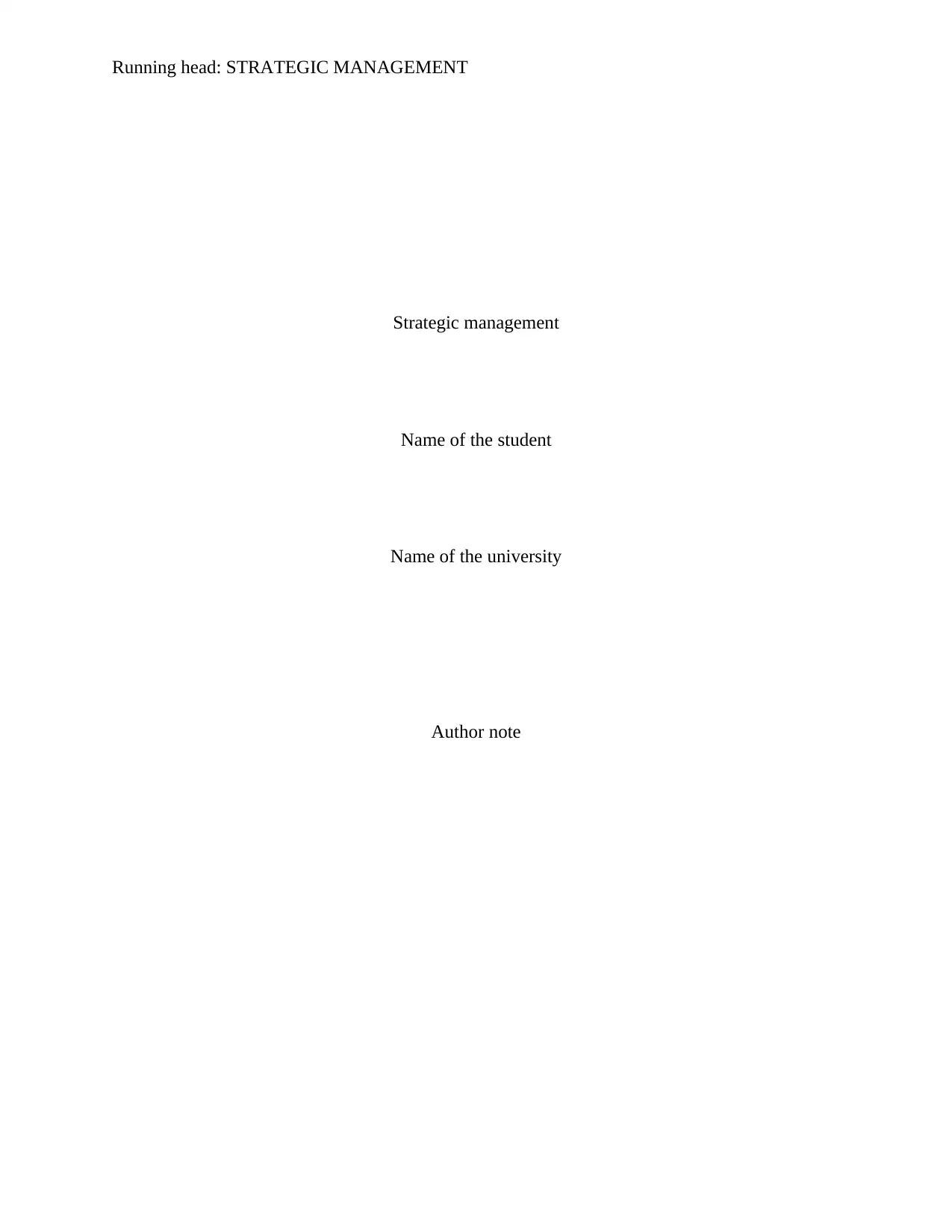
Running head: STRATEGIC MANAGEMENT
Strategic management
Name of the student
Name of the university
Author note
Strategic management
Name of the student
Name of the university
Author note
Secure Best Marks with AI Grader
Need help grading? Try our AI Grader for instant feedback on your assignments.
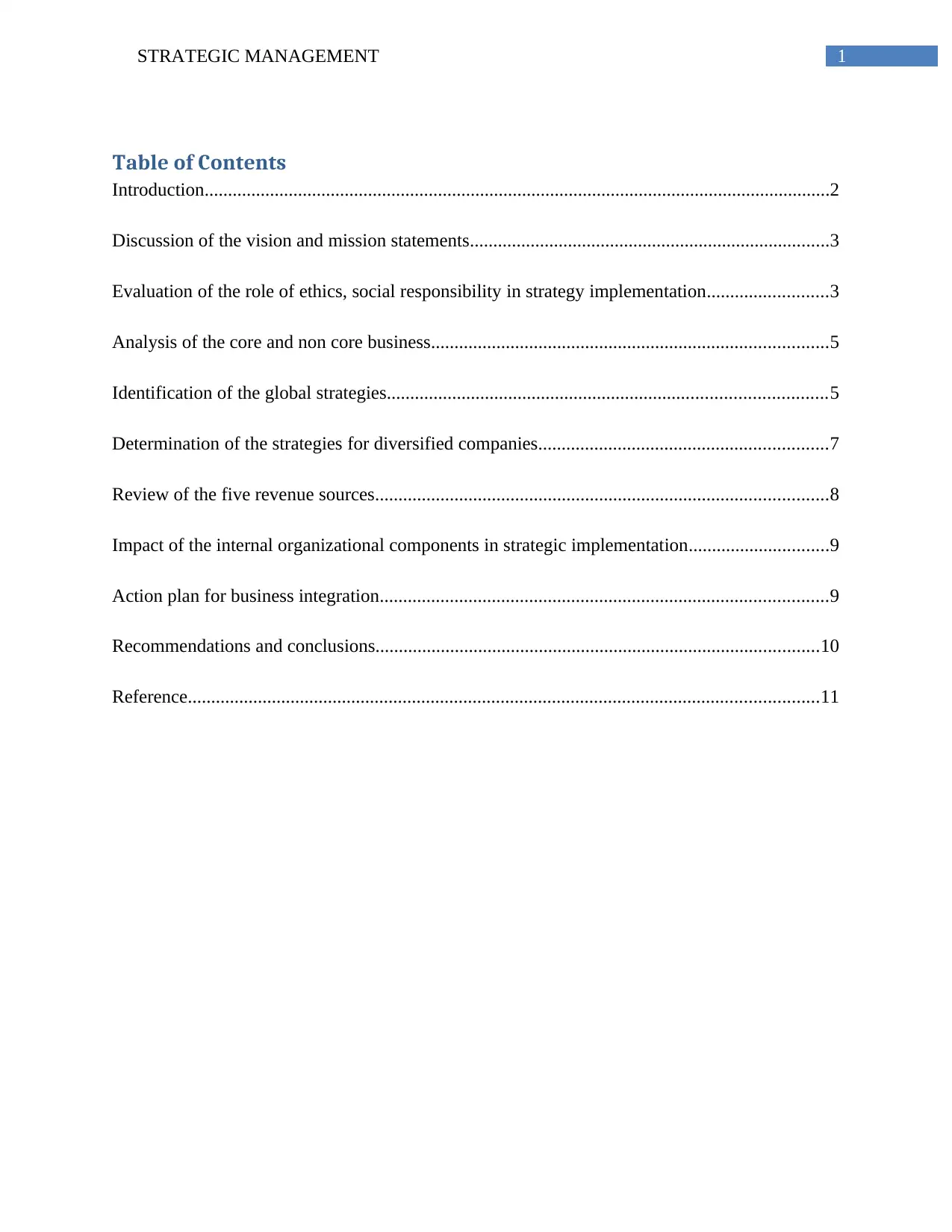
1STRATEGIC MANAGEMENT
Table of Contents
Introduction......................................................................................................................................2
Discussion of the vision and mission statements.............................................................................3
Evaluation of the role of ethics, social responsibility in strategy implementation..........................3
Analysis of the core and non core business.....................................................................................5
Identification of the global strategies..............................................................................................5
Determination of the strategies for diversified companies..............................................................7
Review of the five revenue sources.................................................................................................8
Impact of the internal organizational components in strategic implementation..............................9
Action plan for business integration................................................................................................9
Recommendations and conclusions...............................................................................................10
Reference.......................................................................................................................................11
Table of Contents
Introduction......................................................................................................................................2
Discussion of the vision and mission statements.............................................................................3
Evaluation of the role of ethics, social responsibility in strategy implementation..........................3
Analysis of the core and non core business.....................................................................................5
Identification of the global strategies..............................................................................................5
Determination of the strategies for diversified companies..............................................................7
Review of the five revenue sources.................................................................................................8
Impact of the internal organizational components in strategic implementation..............................9
Action plan for business integration................................................................................................9
Recommendations and conclusions...............................................................................................10
Reference.......................................................................................................................................11
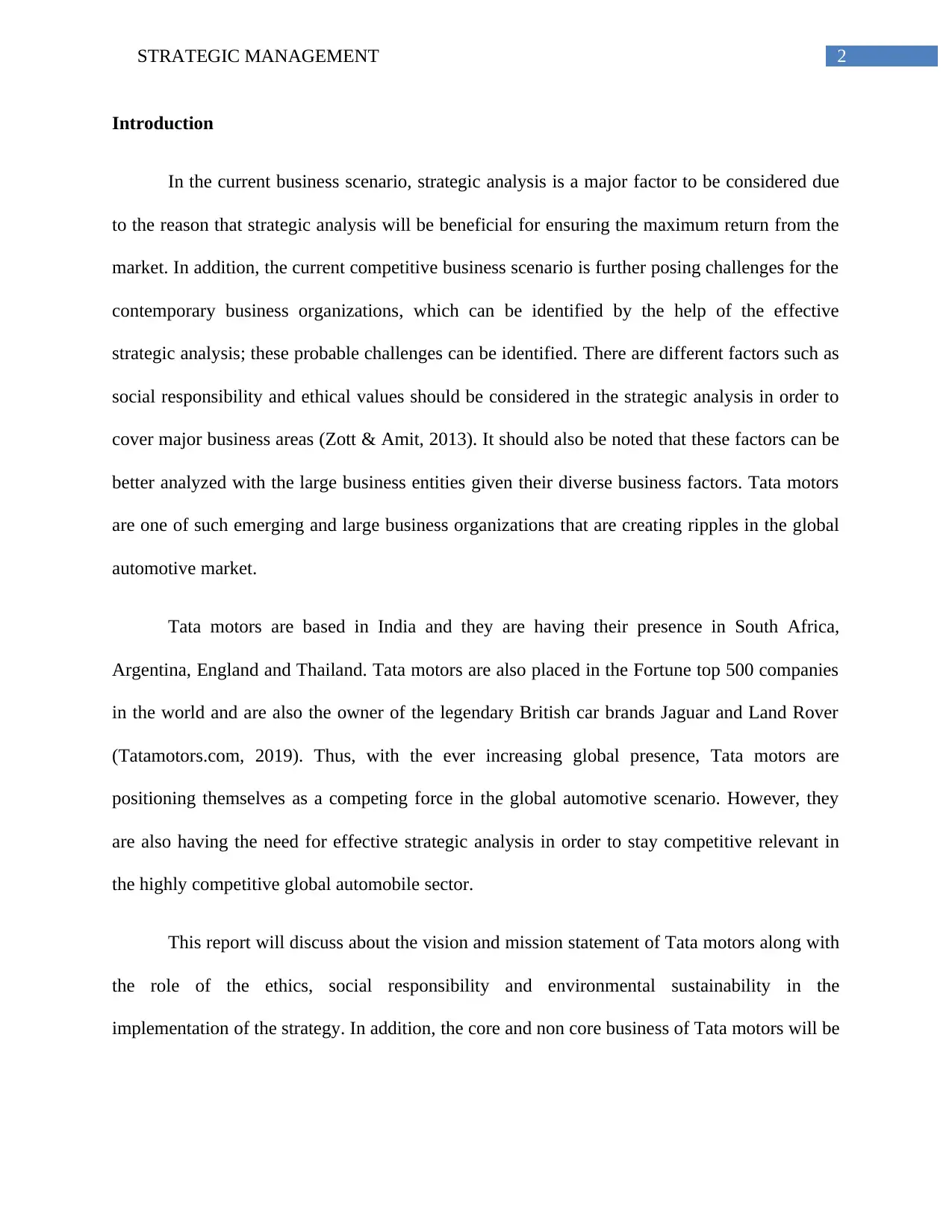
2STRATEGIC MANAGEMENT
Introduction
In the current business scenario, strategic analysis is a major factor to be considered due
to the reason that strategic analysis will be beneficial for ensuring the maximum return from the
market. In addition, the current competitive business scenario is further posing challenges for the
contemporary business organizations, which can be identified by the help of the effective
strategic analysis; these probable challenges can be identified. There are different factors such as
social responsibility and ethical values should be considered in the strategic analysis in order to
cover major business areas (Zott & Amit, 2013). It should also be noted that these factors can be
better analyzed with the large business entities given their diverse business factors. Tata motors
are one of such emerging and large business organizations that are creating ripples in the global
automotive market.
Tata motors are based in India and they are having their presence in South Africa,
Argentina, England and Thailand. Tata motors are also placed in the Fortune top 500 companies
in the world and are also the owner of the legendary British car brands Jaguar and Land Rover
(Tatamotors.com, 2019). Thus, with the ever increasing global presence, Tata motors are
positioning themselves as a competing force in the global automotive scenario. However, they
are also having the need for effective strategic analysis in order to stay competitive relevant in
the highly competitive global automobile sector.
This report will discuss about the vision and mission statement of Tata motors along with
the role of the ethics, social responsibility and environmental sustainability in the
implementation of the strategy. In addition, the core and non core business of Tata motors will be
Introduction
In the current business scenario, strategic analysis is a major factor to be considered due
to the reason that strategic analysis will be beneficial for ensuring the maximum return from the
market. In addition, the current competitive business scenario is further posing challenges for the
contemporary business organizations, which can be identified by the help of the effective
strategic analysis; these probable challenges can be identified. There are different factors such as
social responsibility and ethical values should be considered in the strategic analysis in order to
cover major business areas (Zott & Amit, 2013). It should also be noted that these factors can be
better analyzed with the large business entities given their diverse business factors. Tata motors
are one of such emerging and large business organizations that are creating ripples in the global
automotive market.
Tata motors are based in India and they are having their presence in South Africa,
Argentina, England and Thailand. Tata motors are also placed in the Fortune top 500 companies
in the world and are also the owner of the legendary British car brands Jaguar and Land Rover
(Tatamotors.com, 2019). Thus, with the ever increasing global presence, Tata motors are
positioning themselves as a competing force in the global automotive scenario. However, they
are also having the need for effective strategic analysis in order to stay competitive relevant in
the highly competitive global automobile sector.
This report will discuss about the vision and mission statement of Tata motors along with
the role of the ethics, social responsibility and environmental sustainability in the
implementation of the strategy. In addition, the core and non core business of Tata motors will be
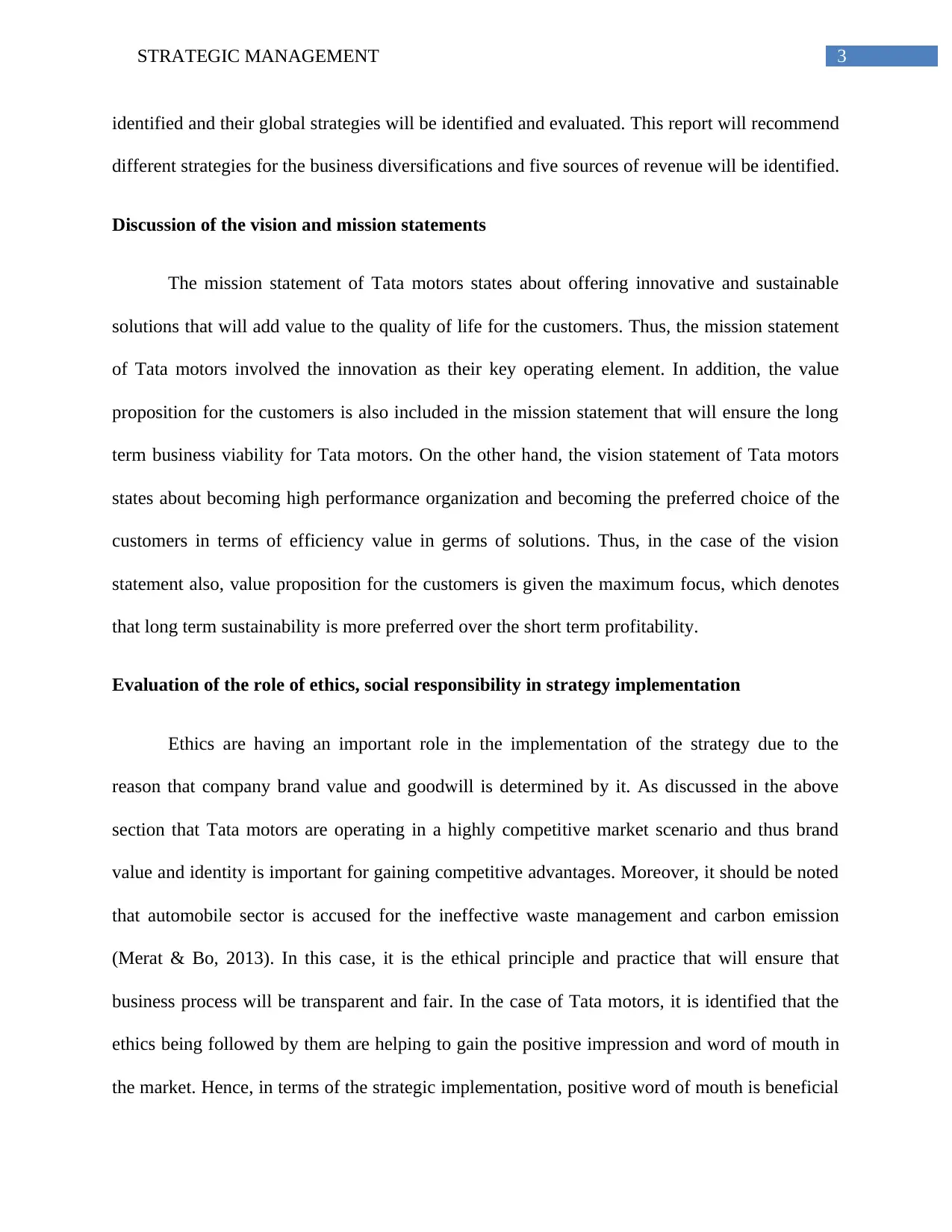
3STRATEGIC MANAGEMENT
identified and their global strategies will be identified and evaluated. This report will recommend
different strategies for the business diversifications and five sources of revenue will be identified.
Discussion of the vision and mission statements
The mission statement of Tata motors states about offering innovative and sustainable
solutions that will add value to the quality of life for the customers. Thus, the mission statement
of Tata motors involved the innovation as their key operating element. In addition, the value
proposition for the customers is also included in the mission statement that will ensure the long
term business viability for Tata motors. On the other hand, the vision statement of Tata motors
states about becoming high performance organization and becoming the preferred choice of the
customers in terms of efficiency value in germs of solutions. Thus, in the case of the vision
statement also, value proposition for the customers is given the maximum focus, which denotes
that long term sustainability is more preferred over the short term profitability.
Evaluation of the role of ethics, social responsibility in strategy implementation
Ethics are having an important role in the implementation of the strategy due to the
reason that company brand value and goodwill is determined by it. As discussed in the above
section that Tata motors are operating in a highly competitive market scenario and thus brand
value and identity is important for gaining competitive advantages. Moreover, it should be noted
that automobile sector is accused for the ineffective waste management and carbon emission
(Merat & Bo, 2013). In this case, it is the ethical principle and practice that will ensure that
business process will be transparent and fair. In the case of Tata motors, it is identified that the
ethics being followed by them are helping to gain the positive impression and word of mouth in
the market. Hence, in terms of the strategic implementation, positive word of mouth is beneficial
identified and their global strategies will be identified and evaluated. This report will recommend
different strategies for the business diversifications and five sources of revenue will be identified.
Discussion of the vision and mission statements
The mission statement of Tata motors states about offering innovative and sustainable
solutions that will add value to the quality of life for the customers. Thus, the mission statement
of Tata motors involved the innovation as their key operating element. In addition, the value
proposition for the customers is also included in the mission statement that will ensure the long
term business viability for Tata motors. On the other hand, the vision statement of Tata motors
states about becoming high performance organization and becoming the preferred choice of the
customers in terms of efficiency value in germs of solutions. Thus, in the case of the vision
statement also, value proposition for the customers is given the maximum focus, which denotes
that long term sustainability is more preferred over the short term profitability.
Evaluation of the role of ethics, social responsibility in strategy implementation
Ethics are having an important role in the implementation of the strategy due to the
reason that company brand value and goodwill is determined by it. As discussed in the above
section that Tata motors are operating in a highly competitive market scenario and thus brand
value and identity is important for gaining competitive advantages. Moreover, it should be noted
that automobile sector is accused for the ineffective waste management and carbon emission
(Merat & Bo, 2013). In this case, it is the ethical principle and practice that will ensure that
business process will be transparent and fair. In the case of Tata motors, it is identified that the
ethics being followed by them are helping to gain the positive impression and word of mouth in
the market. Hence, in terms of the strategic implementation, positive word of mouth is beneficial
Secure Best Marks with AI Grader
Need help grading? Try our AI Grader for instant feedback on your assignments.
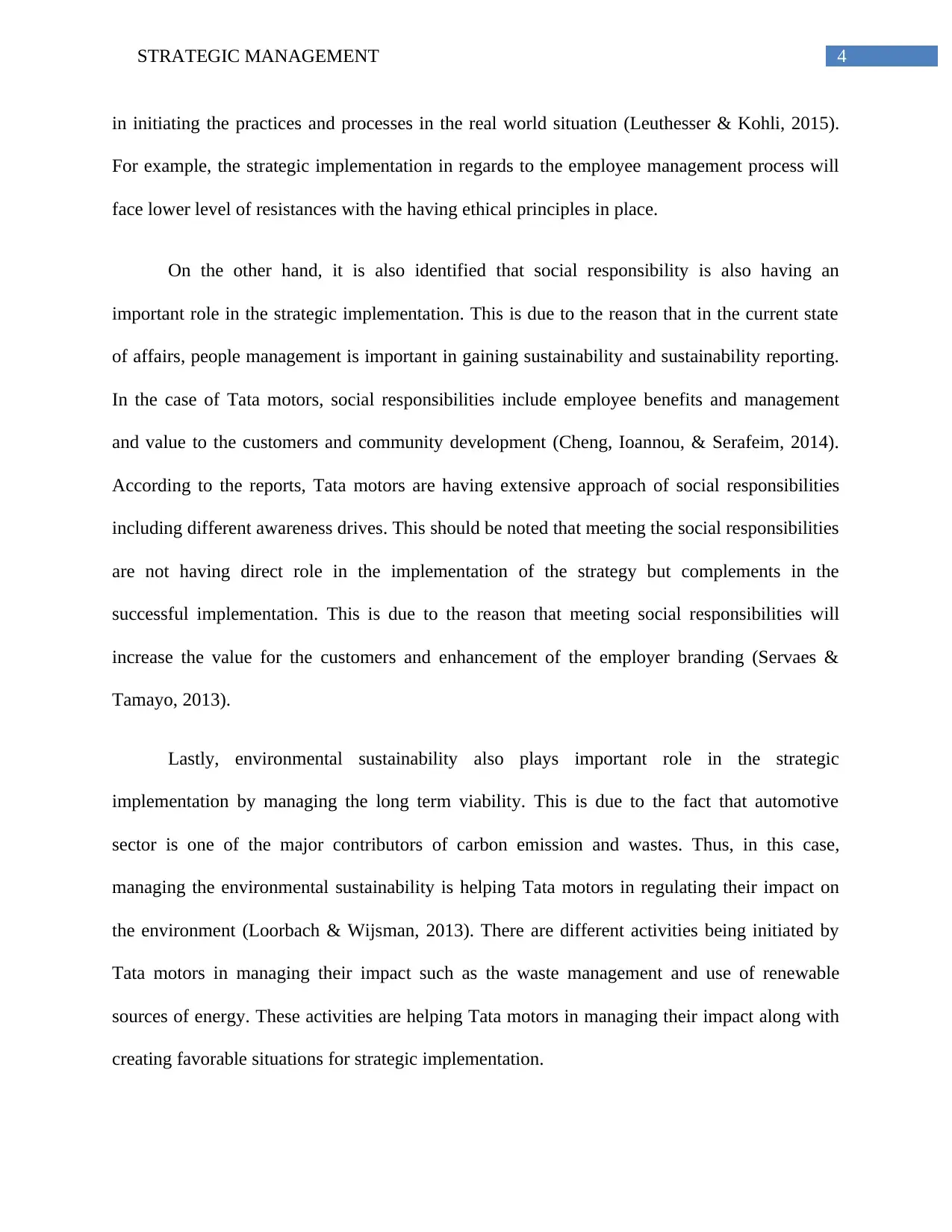
4STRATEGIC MANAGEMENT
in initiating the practices and processes in the real world situation (Leuthesser & Kohli, 2015).
For example, the strategic implementation in regards to the employee management process will
face lower level of resistances with the having ethical principles in place.
On the other hand, it is also identified that social responsibility is also having an
important role in the strategic implementation. This is due to the reason that in the current state
of affairs, people management is important in gaining sustainability and sustainability reporting.
In the case of Tata motors, social responsibilities include employee benefits and management
and value to the customers and community development (Cheng, Ioannou, & Serafeim, 2014).
According to the reports, Tata motors are having extensive approach of social responsibilities
including different awareness drives. This should be noted that meeting the social responsibilities
are not having direct role in the implementation of the strategy but complements in the
successful implementation. This is due to the reason that meeting social responsibilities will
increase the value for the customers and enhancement of the employer branding (Servaes &
Tamayo, 2013).
Lastly, environmental sustainability also plays important role in the strategic
implementation by managing the long term viability. This is due to the fact that automotive
sector is one of the major contributors of carbon emission and wastes. Thus, in this case,
managing the environmental sustainability is helping Tata motors in regulating their impact on
the environment (Loorbach & Wijsman, 2013). There are different activities being initiated by
Tata motors in managing their impact such as the waste management and use of renewable
sources of energy. These activities are helping Tata motors in managing their impact along with
creating favorable situations for strategic implementation.
in initiating the practices and processes in the real world situation (Leuthesser & Kohli, 2015).
For example, the strategic implementation in regards to the employee management process will
face lower level of resistances with the having ethical principles in place.
On the other hand, it is also identified that social responsibility is also having an
important role in the strategic implementation. This is due to the reason that in the current state
of affairs, people management is important in gaining sustainability and sustainability reporting.
In the case of Tata motors, social responsibilities include employee benefits and management
and value to the customers and community development (Cheng, Ioannou, & Serafeim, 2014).
According to the reports, Tata motors are having extensive approach of social responsibilities
including different awareness drives. This should be noted that meeting the social responsibilities
are not having direct role in the implementation of the strategy but complements in the
successful implementation. This is due to the reason that meeting social responsibilities will
increase the value for the customers and enhancement of the employer branding (Servaes &
Tamayo, 2013).
Lastly, environmental sustainability also plays important role in the strategic
implementation by managing the long term viability. This is due to the fact that automotive
sector is one of the major contributors of carbon emission and wastes. Thus, in this case,
managing the environmental sustainability is helping Tata motors in regulating their impact on
the environment (Loorbach & Wijsman, 2013). There are different activities being initiated by
Tata motors in managing their impact such as the waste management and use of renewable
sources of energy. These activities are helping Tata motors in managing their impact along with
creating favorable situations for strategic implementation.
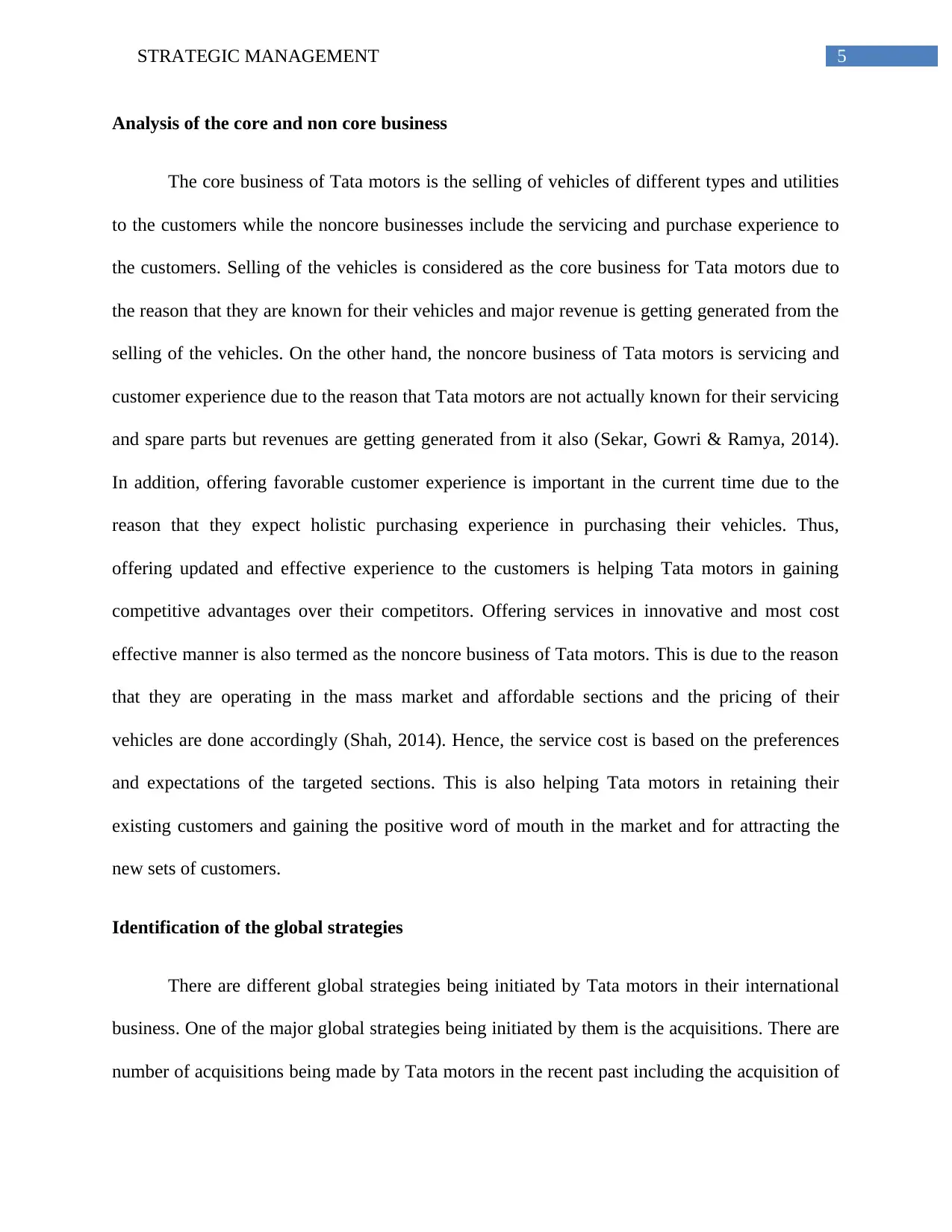
5STRATEGIC MANAGEMENT
Analysis of the core and non core business
The core business of Tata motors is the selling of vehicles of different types and utilities
to the customers while the noncore businesses include the servicing and purchase experience to
the customers. Selling of the vehicles is considered as the core business for Tata motors due to
the reason that they are known for their vehicles and major revenue is getting generated from the
selling of the vehicles. On the other hand, the noncore business of Tata motors is servicing and
customer experience due to the reason that Tata motors are not actually known for their servicing
and spare parts but revenues are getting generated from it also (Sekar, Gowri & Ramya, 2014).
In addition, offering favorable customer experience is important in the current time due to the
reason that they expect holistic purchasing experience in purchasing their vehicles. Thus,
offering updated and effective experience to the customers is helping Tata motors in gaining
competitive advantages over their competitors. Offering services in innovative and most cost
effective manner is also termed as the noncore business of Tata motors. This is due to the reason
that they are operating in the mass market and affordable sections and the pricing of their
vehicles are done accordingly (Shah, 2014). Hence, the service cost is based on the preferences
and expectations of the targeted sections. This is also helping Tata motors in retaining their
existing customers and gaining the positive word of mouth in the market and for attracting the
new sets of customers.
Identification of the global strategies
There are different global strategies being initiated by Tata motors in their international
business. One of the major global strategies being initiated by them is the acquisitions. There are
number of acquisitions being made by Tata motors in the recent past including the acquisition of
Analysis of the core and non core business
The core business of Tata motors is the selling of vehicles of different types and utilities
to the customers while the noncore businesses include the servicing and purchase experience to
the customers. Selling of the vehicles is considered as the core business for Tata motors due to
the reason that they are known for their vehicles and major revenue is getting generated from the
selling of the vehicles. On the other hand, the noncore business of Tata motors is servicing and
customer experience due to the reason that Tata motors are not actually known for their servicing
and spare parts but revenues are getting generated from it also (Sekar, Gowri & Ramya, 2014).
In addition, offering favorable customer experience is important in the current time due to the
reason that they expect holistic purchasing experience in purchasing their vehicles. Thus,
offering updated and effective experience to the customers is helping Tata motors in gaining
competitive advantages over their competitors. Offering services in innovative and most cost
effective manner is also termed as the noncore business of Tata motors. This is due to the reason
that they are operating in the mass market and affordable sections and the pricing of their
vehicles are done accordingly (Shah, 2014). Hence, the service cost is based on the preferences
and expectations of the targeted sections. This is also helping Tata motors in retaining their
existing customers and gaining the positive word of mouth in the market and for attracting the
new sets of customers.
Identification of the global strategies
There are different global strategies being initiated by Tata motors in their international
business. One of the major global strategies being initiated by them is the acquisitions. There are
number of acquisitions being made by Tata motors in the recent past including the acquisition of

6STRATEGIC MANAGEMENT
Jaguar and Land Rover and Daewoo Motors. This strategy is being initiated by them because of
gaining of competitive advantages from the external expertise and to gain the market presence in
the foreign markets (Phillips & Zhdanov, 2013). It is reported that prior to the 2004, majority of
the business revenue of Tata motors are depended on the Tata motors with more than 94 percent
of revenues were getting generated from the Indian markets only. Thus, with the help of the
acquisitions, Tata motors were able to fortify their positions in the foreign markets as well. For
example, the market presence of Tata motors in the western countries is mainly due to the
acquisition of the Jaguar and Land Rover. These markets would not have catered with the
existing portfolio of Tata motors. On the other hand, another objective behind the acquisitions is
go expertise. This is due to the reason that Tata motors was not having any expertise in the
premium segments and their initial models even in their home country were considered inferior
compared to the global rivals (Kansal & Chandani, 2014). Thus, it was important for Tata motors
to gain expertise in the new product development in order to gain the long term business
sustainability. In this case, the acquisition of Jaguar and land Rover helped Tata motors to gain
the technological advancements of the former. It is evident in the product development process
of Tata motors due to the fact that newer generation cars of them are getting built on the
platforms and chassis of Land Rovers.
Another objective of acquisition strategy of Tata motors is also to gain expertise in
different market segments. For example, prior to the acquisition of the Daewoo motors, Tata
motors were not having heavy vehicle portfolio with global standards and it cause challenges for
them as international brands such as Mercedes and Volvo and Navistar started to tap the Indian
market. Thus, with the acquisition of the Daewoo motors, Tata motors are being able to gain the
insights of heavy vehicle manufacturing with global standards (Mathur & Agarwal, 2016).
Jaguar and Land Rover and Daewoo Motors. This strategy is being initiated by them because of
gaining of competitive advantages from the external expertise and to gain the market presence in
the foreign markets (Phillips & Zhdanov, 2013). It is reported that prior to the 2004, majority of
the business revenue of Tata motors are depended on the Tata motors with more than 94 percent
of revenues were getting generated from the Indian markets only. Thus, with the help of the
acquisitions, Tata motors were able to fortify their positions in the foreign markets as well. For
example, the market presence of Tata motors in the western countries is mainly due to the
acquisition of the Jaguar and Land Rover. These markets would not have catered with the
existing portfolio of Tata motors. On the other hand, another objective behind the acquisitions is
go expertise. This is due to the reason that Tata motors was not having any expertise in the
premium segments and their initial models even in their home country were considered inferior
compared to the global rivals (Kansal & Chandani, 2014). Thus, it was important for Tata motors
to gain expertise in the new product development in order to gain the long term business
sustainability. In this case, the acquisition of Jaguar and land Rover helped Tata motors to gain
the technological advancements of the former. It is evident in the product development process
of Tata motors due to the fact that newer generation cars of them are getting built on the
platforms and chassis of Land Rovers.
Another objective of acquisition strategy of Tata motors is also to gain expertise in
different market segments. For example, prior to the acquisition of the Daewoo motors, Tata
motors were not having heavy vehicle portfolio with global standards and it cause challenges for
them as international brands such as Mercedes and Volvo and Navistar started to tap the Indian
market. Thus, with the acquisition of the Daewoo motors, Tata motors are being able to gain the
insights of heavy vehicle manufacturing with global standards (Mathur & Agarwal, 2016).
Paraphrase This Document
Need a fresh take? Get an instant paraphrase of this document with our AI Paraphraser

7STRATEGIC MANAGEMENT
Hence, it can be concluded that acquisition strategy of Tata motors helped them in gaining
competitive advantages from multiple ways. It should also be noted that other from acquisition
strategy, Tata motors are also involved in joint venture with different entities such as joint
venture with Hitachi, Fiat and Marco-polo. Each of these joint ventures is helping Tata motors in
getting footprint in different segments. For example, joint venture between Tata motors and
Hitachi heavy machinery is helping in gaining market presence in the construction machinery
sector. On the other hand, joint venture with Fiat Chrysler is helping the former in getting the
access to the world renowned combustion technology (Kale, 2017). Thus, it can be concluded
that with the help of joint ventures with different international brands, Tata motors are being able
to gain competencies in meeting the diverse needs of the global market.
Determination of the strategies for diversified companies
It should be noted that Tata motors are the subsidiary of Tata Sons, which is a leading
conglomerate in the South Asian region. Currently, Tata Sons are having their business in fast
moving consumer goods, airline, food, fashion and automobile sector, which denotes that they
are highly diversified in nature. However, in this report, the major focus in on the Tata motors
and diversification of only the Tata motors will be discussed. Tata motors are having presence in
heavy construction machinery segment, light vehicles segment, heavy vehicles segment and
passenger vehicle segment (Alessandri & Seth, 2014). However, conglomeration will not be
effective for Tata motors due to the reason that their parent company is already diversified and
unrelated business segment will be not be successful under the brand of Tata motors. In this case,
it is recommended that Tata motors should have their presence in the two wheeler market. This is
due to the reason that two wheeler markets is having huge potentiality and opportunity for
market penetration is also more compared to the four wheeler market. As of now, Tata motors
Hence, it can be concluded that acquisition strategy of Tata motors helped them in gaining
competitive advantages from multiple ways. It should also be noted that other from acquisition
strategy, Tata motors are also involved in joint venture with different entities such as joint
venture with Hitachi, Fiat and Marco-polo. Each of these joint ventures is helping Tata motors in
getting footprint in different segments. For example, joint venture between Tata motors and
Hitachi heavy machinery is helping in gaining market presence in the construction machinery
sector. On the other hand, joint venture with Fiat Chrysler is helping the former in getting the
access to the world renowned combustion technology (Kale, 2017). Thus, it can be concluded
that with the help of joint ventures with different international brands, Tata motors are being able
to gain competencies in meeting the diverse needs of the global market.
Determination of the strategies for diversified companies
It should be noted that Tata motors are the subsidiary of Tata Sons, which is a leading
conglomerate in the South Asian region. Currently, Tata Sons are having their business in fast
moving consumer goods, airline, food, fashion and automobile sector, which denotes that they
are highly diversified in nature. However, in this report, the major focus in on the Tata motors
and diversification of only the Tata motors will be discussed. Tata motors are having presence in
heavy construction machinery segment, light vehicles segment, heavy vehicles segment and
passenger vehicle segment (Alessandri & Seth, 2014). However, conglomeration will not be
effective for Tata motors due to the reason that their parent company is already diversified and
unrelated business segment will be not be successful under the brand of Tata motors. In this case,
it is recommended that Tata motors should have their presence in the two wheeler market. This is
due to the reason that two wheeler markets is having huge potentiality and opportunity for
market penetration is also more compared to the four wheeler market. As of now, Tata motors
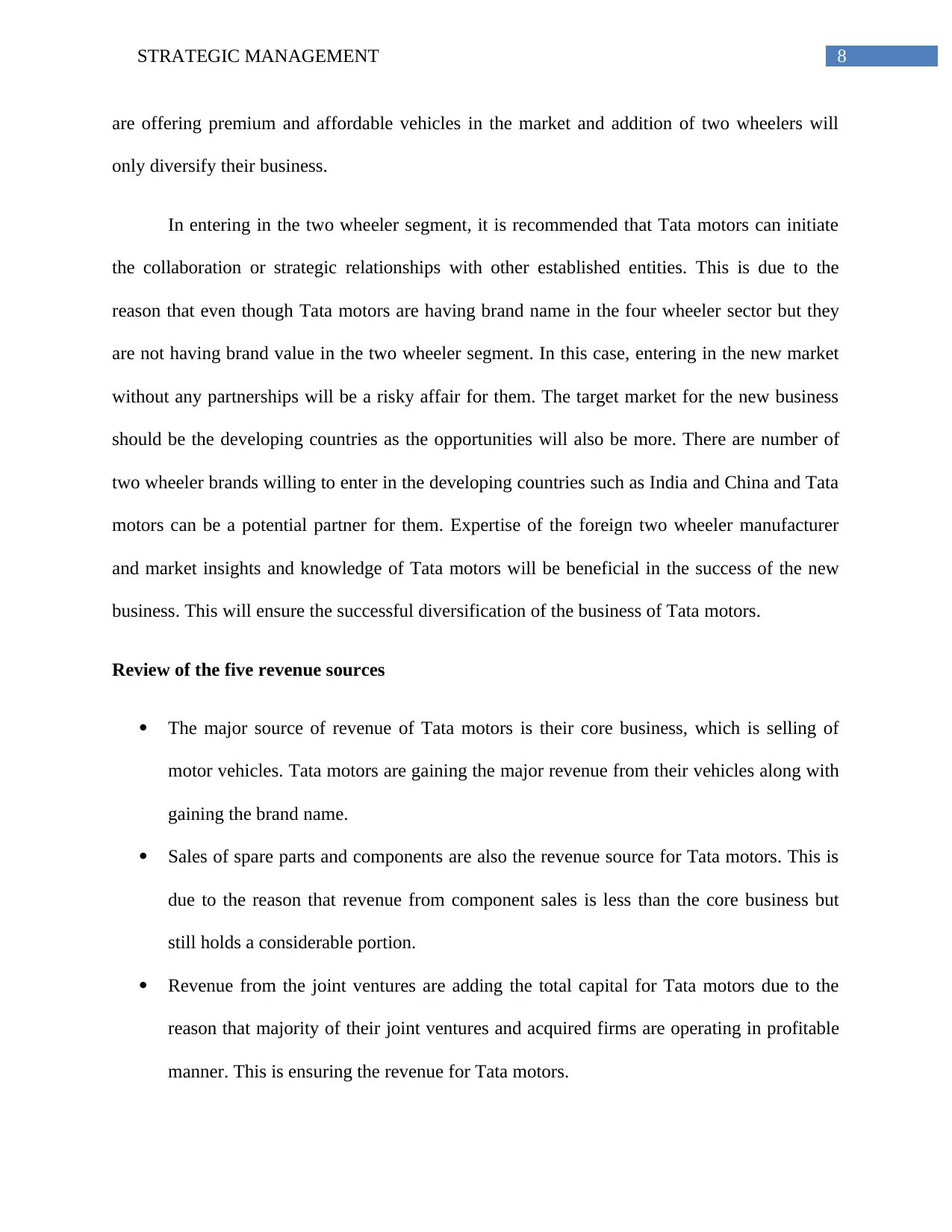
8STRATEGIC MANAGEMENT
are offering premium and affordable vehicles in the market and addition of two wheelers will
only diversify their business.
In entering in the two wheeler segment, it is recommended that Tata motors can initiate
the collaboration or strategic relationships with other established entities. This is due to the
reason that even though Tata motors are having brand name in the four wheeler sector but they
are not having brand value in the two wheeler segment. In this case, entering in the new market
without any partnerships will be a risky affair for them. The target market for the new business
should be the developing countries as the opportunities will also be more. There are number of
two wheeler brands willing to enter in the developing countries such as India and China and Tata
motors can be a potential partner for them. Expertise of the foreign two wheeler manufacturer
and market insights and knowledge of Tata motors will be beneficial in the success of the new
business. This will ensure the successful diversification of the business of Tata motors.
Review of the five revenue sources
The major source of revenue of Tata motors is their core business, which is selling of
motor vehicles. Tata motors are gaining the major revenue from their vehicles along with
gaining the brand name.
Sales of spare parts and components are also the revenue source for Tata motors. This is
due to the reason that revenue from component sales is less than the core business but
still holds a considerable portion.
Revenue from the joint ventures are adding the total capital for Tata motors due to the
reason that majority of their joint ventures and acquired firms are operating in profitable
manner. This is ensuring the revenue for Tata motors.
are offering premium and affordable vehicles in the market and addition of two wheelers will
only diversify their business.
In entering in the two wheeler segment, it is recommended that Tata motors can initiate
the collaboration or strategic relationships with other established entities. This is due to the
reason that even though Tata motors are having brand name in the four wheeler sector but they
are not having brand value in the two wheeler segment. In this case, entering in the new market
without any partnerships will be a risky affair for them. The target market for the new business
should be the developing countries as the opportunities will also be more. There are number of
two wheeler brands willing to enter in the developing countries such as India and China and Tata
motors can be a potential partner for them. Expertise of the foreign two wheeler manufacturer
and market insights and knowledge of Tata motors will be beneficial in the success of the new
business. This will ensure the successful diversification of the business of Tata motors.
Review of the five revenue sources
The major source of revenue of Tata motors is their core business, which is selling of
motor vehicles. Tata motors are gaining the major revenue from their vehicles along with
gaining the brand name.
Sales of spare parts and components are also the revenue source for Tata motors. This is
due to the reason that revenue from component sales is less than the core business but
still holds a considerable portion.
Revenue from the joint ventures are adding the total capital for Tata motors due to the
reason that majority of their joint ventures and acquired firms are operating in profitable
manner. This is ensuring the revenue for Tata motors.
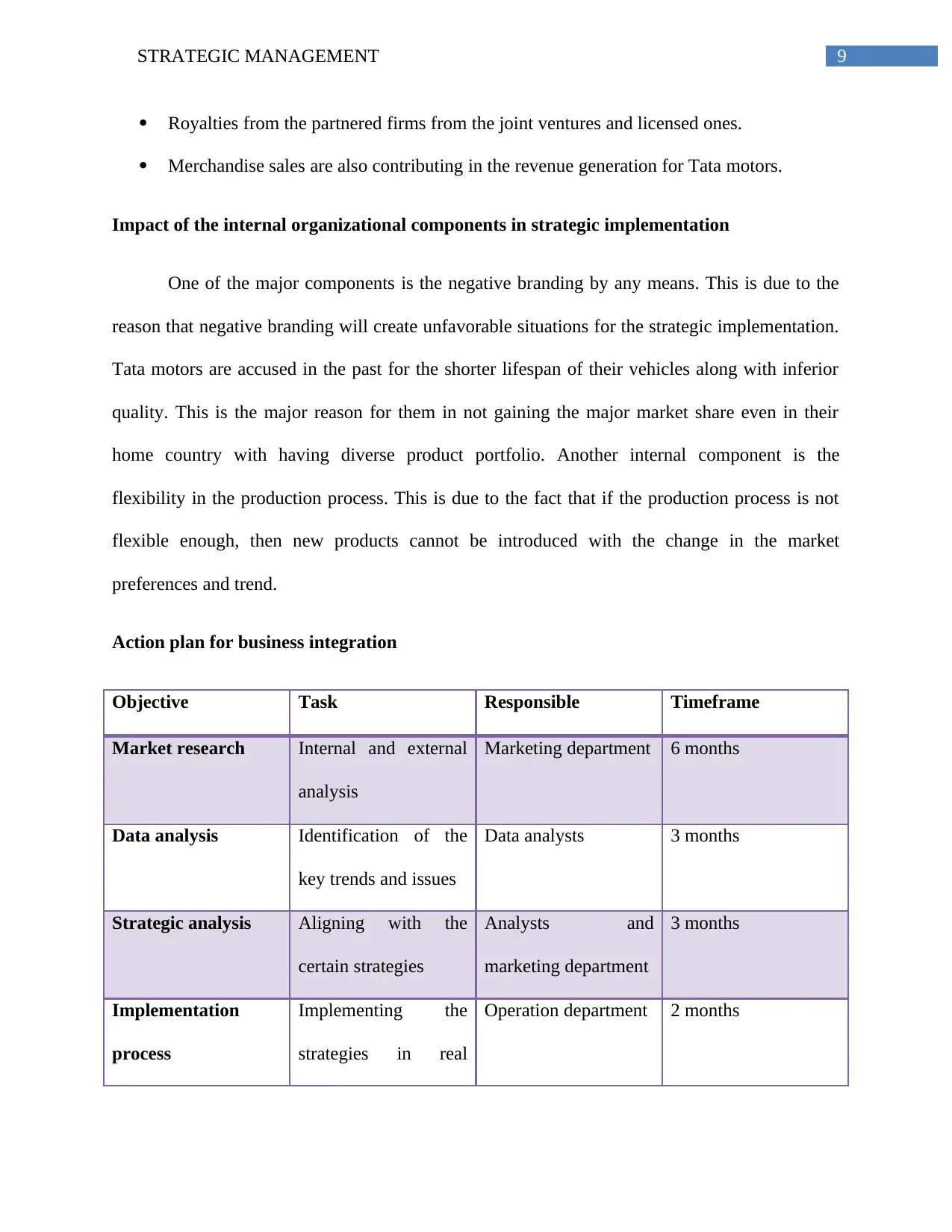
9STRATEGIC MANAGEMENT
Royalties from the partnered firms from the joint ventures and licensed ones.
Merchandise sales are also contributing in the revenue generation for Tata motors.
Impact of the internal organizational components in strategic implementation
One of the major components is the negative branding by any means. This is due to the
reason that negative branding will create unfavorable situations for the strategic implementation.
Tata motors are accused in the past for the shorter lifespan of their vehicles along with inferior
quality. This is the major reason for them in not gaining the major market share even in their
home country with having diverse product portfolio. Another internal component is the
flexibility in the production process. This is due to the fact that if the production process is not
flexible enough, then new products cannot be introduced with the change in the market
preferences and trend.
Action plan for business integration
Objective Task Responsible Timeframe
Market research Internal and external
analysis
Marketing department 6 months
Data analysis Identification of the
key trends and issues
Data analysts 3 months
Strategic analysis Aligning with the
certain strategies
Analysts and
marketing department
3 months
Implementation
process
Implementing the
strategies in real
Operation department 2 months
Royalties from the partnered firms from the joint ventures and licensed ones.
Merchandise sales are also contributing in the revenue generation for Tata motors.
Impact of the internal organizational components in strategic implementation
One of the major components is the negative branding by any means. This is due to the
reason that negative branding will create unfavorable situations for the strategic implementation.
Tata motors are accused in the past for the shorter lifespan of their vehicles along with inferior
quality. This is the major reason for them in not gaining the major market share even in their
home country with having diverse product portfolio. Another internal component is the
flexibility in the production process. This is due to the fact that if the production process is not
flexible enough, then new products cannot be introduced with the change in the market
preferences and trend.
Action plan for business integration
Objective Task Responsible Timeframe
Market research Internal and external
analysis
Marketing department 6 months
Data analysis Identification of the
key trends and issues
Data analysts 3 months
Strategic analysis Aligning with the
certain strategies
Analysts and
marketing department
3 months
Implementation
process
Implementing the
strategies in real
Operation department 2 months
Secure Best Marks with AI Grader
Need help grading? Try our AI Grader for instant feedback on your assignments.
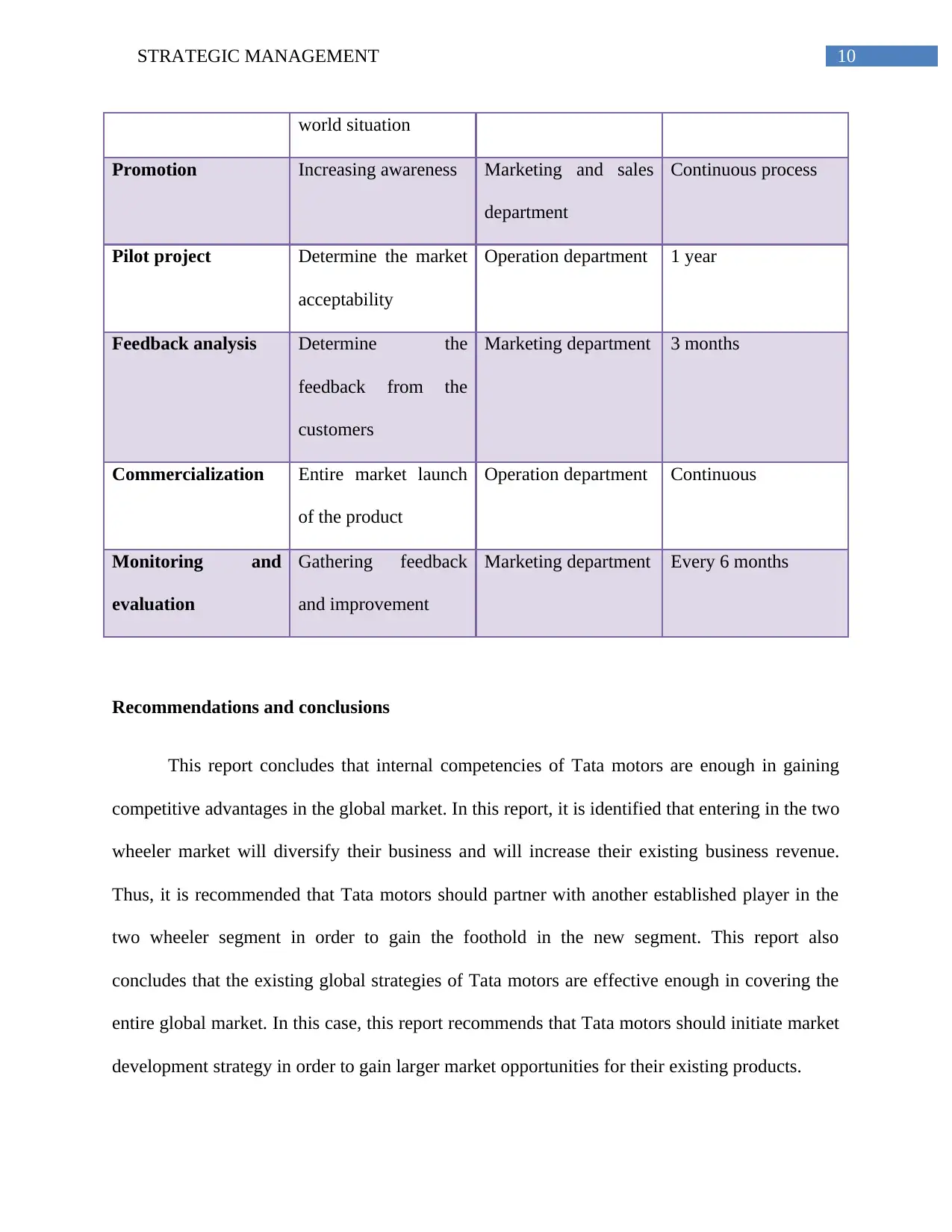
10STRATEGIC MANAGEMENT
world situation
Promotion Increasing awareness Marketing and sales
department
Continuous process
Pilot project Determine the market
acceptability
Operation department 1 year
Feedback analysis Determine the
feedback from the
customers
Marketing department 3 months
Commercialization Entire market launch
of the product
Operation department Continuous
Monitoring and
evaluation
Gathering feedback
and improvement
Marketing department Every 6 months
Recommendations and conclusions
This report concludes that internal competencies of Tata motors are enough in gaining
competitive advantages in the global market. In this report, it is identified that entering in the two
wheeler market will diversify their business and will increase their existing business revenue.
Thus, it is recommended that Tata motors should partner with another established player in the
two wheeler segment in order to gain the foothold in the new segment. This report also
concludes that the existing global strategies of Tata motors are effective enough in covering the
entire global market. In this case, this report recommends that Tata motors should initiate market
development strategy in order to gain larger market opportunities for their existing products.
world situation
Promotion Increasing awareness Marketing and sales
department
Continuous process
Pilot project Determine the market
acceptability
Operation department 1 year
Feedback analysis Determine the
feedback from the
customers
Marketing department 3 months
Commercialization Entire market launch
of the product
Operation department Continuous
Monitoring and
evaluation
Gathering feedback
and improvement
Marketing department Every 6 months
Recommendations and conclusions
This report concludes that internal competencies of Tata motors are enough in gaining
competitive advantages in the global market. In this report, it is identified that entering in the two
wheeler market will diversify their business and will increase their existing business revenue.
Thus, it is recommended that Tata motors should partner with another established player in the
two wheeler segment in order to gain the foothold in the new segment. This report also
concludes that the existing global strategies of Tata motors are effective enough in covering the
entire global market. In this case, this report recommends that Tata motors should initiate market
development strategy in order to gain larger market opportunities for their existing products.
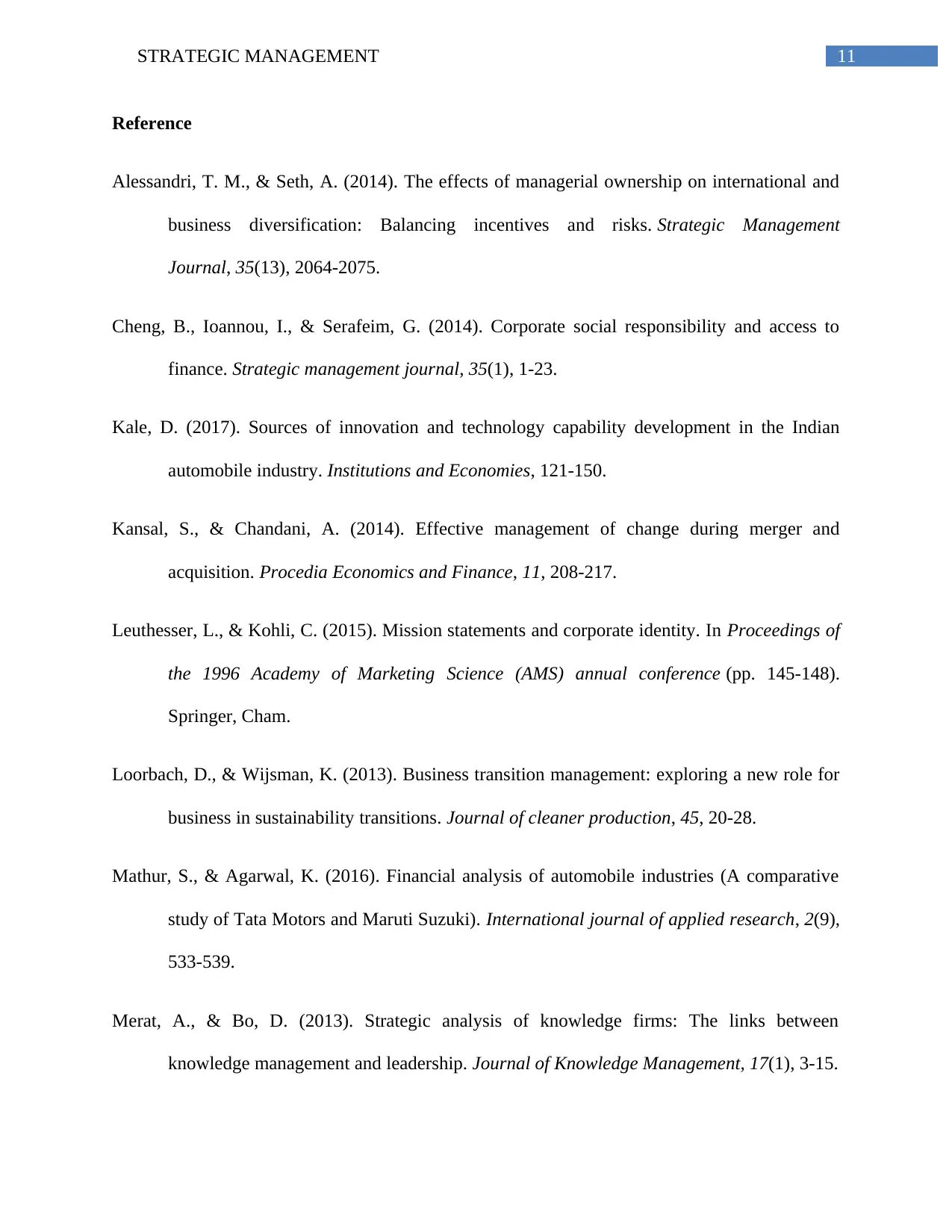
11STRATEGIC MANAGEMENT
Reference
Alessandri, T. M., & Seth, A. (2014). The effects of managerial ownership on international and
business diversification: Balancing incentives and risks. Strategic Management
Journal, 35(13), 2064-2075.
Cheng, B., Ioannou, I., & Serafeim, G. (2014). Corporate social responsibility and access to
finance. Strategic management journal, 35(1), 1-23.
Kale, D. (2017). Sources of innovation and technology capability development in the Indian
automobile industry. Institutions and Economies, 121-150.
Kansal, S., & Chandani, A. (2014). Effective management of change during merger and
acquisition. Procedia Economics and Finance, 11, 208-217.
Leuthesser, L., & Kohli, C. (2015). Mission statements and corporate identity. In Proceedings of
the 1996 Academy of Marketing Science (AMS) annual conference (pp. 145-148).
Springer, Cham.
Loorbach, D., & Wijsman, K. (2013). Business transition management: exploring a new role for
business in sustainability transitions. Journal of cleaner production, 45, 20-28.
Mathur, S., & Agarwal, K. (2016). Financial analysis of automobile industries (A comparative
study of Tata Motors and Maruti Suzuki). International journal of applied research, 2(9),
533-539.
Merat, A., & Bo, D. (2013). Strategic analysis of knowledge firms: The links between
knowledge management and leadership. Journal of Knowledge Management, 17(1), 3-15.
Reference
Alessandri, T. M., & Seth, A. (2014). The effects of managerial ownership on international and
business diversification: Balancing incentives and risks. Strategic Management
Journal, 35(13), 2064-2075.
Cheng, B., Ioannou, I., & Serafeim, G. (2014). Corporate social responsibility and access to
finance. Strategic management journal, 35(1), 1-23.
Kale, D. (2017). Sources of innovation and technology capability development in the Indian
automobile industry. Institutions and Economies, 121-150.
Kansal, S., & Chandani, A. (2014). Effective management of change during merger and
acquisition. Procedia Economics and Finance, 11, 208-217.
Leuthesser, L., & Kohli, C. (2015). Mission statements and corporate identity. In Proceedings of
the 1996 Academy of Marketing Science (AMS) annual conference (pp. 145-148).
Springer, Cham.
Loorbach, D., & Wijsman, K. (2013). Business transition management: exploring a new role for
business in sustainability transitions. Journal of cleaner production, 45, 20-28.
Mathur, S., & Agarwal, K. (2016). Financial analysis of automobile industries (A comparative
study of Tata Motors and Maruti Suzuki). International journal of applied research, 2(9),
533-539.
Merat, A., & Bo, D. (2013). Strategic analysis of knowledge firms: The links between
knowledge management and leadership. Journal of Knowledge Management, 17(1), 3-15.
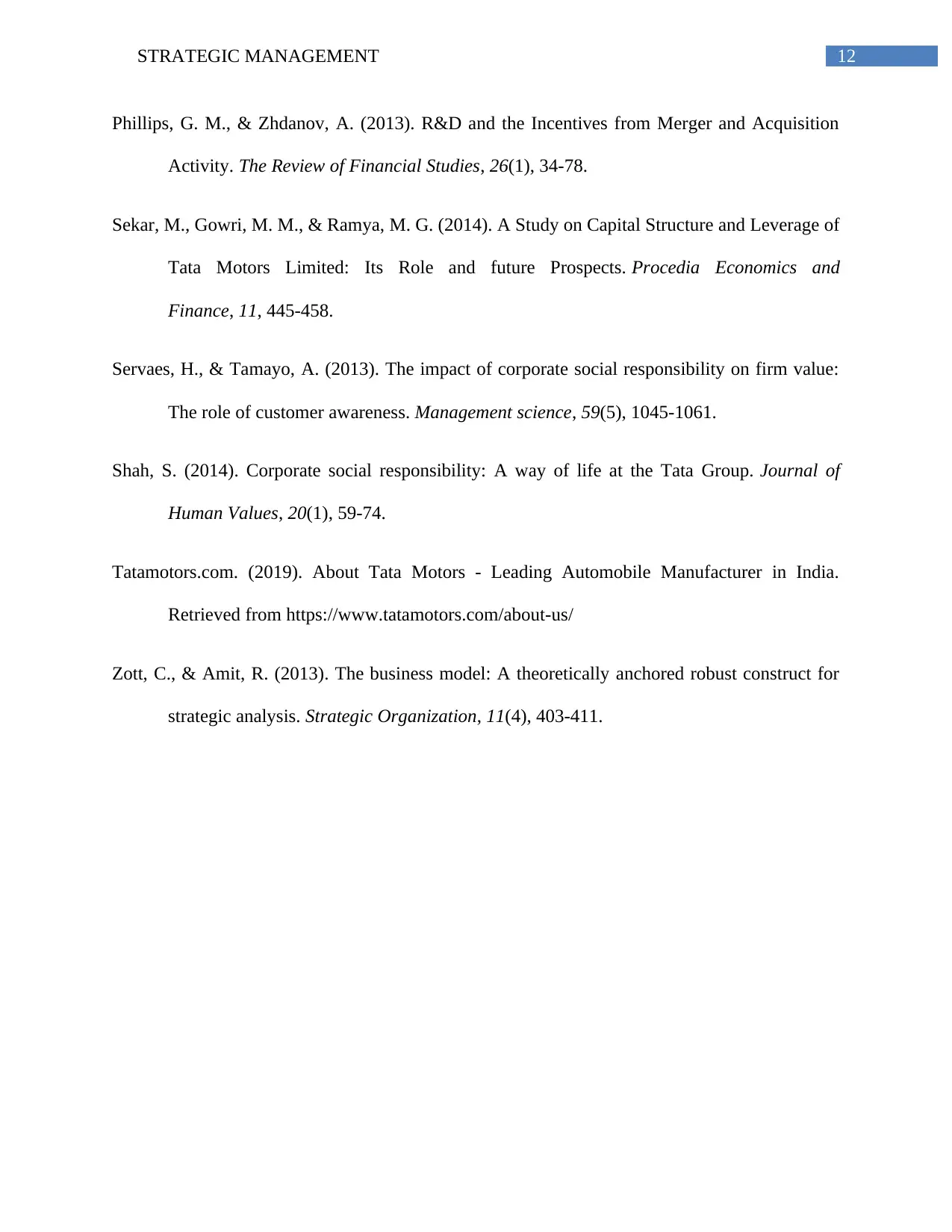
12STRATEGIC MANAGEMENT
Phillips, G. M., & Zhdanov, A. (2013). R&D and the Incentives from Merger and Acquisition
Activity. The Review of Financial Studies, 26(1), 34-78.
Sekar, M., Gowri, M. M., & Ramya, M. G. (2014). A Study on Capital Structure and Leverage of
Tata Motors Limited: Its Role and future Prospects. Procedia Economics and
Finance, 11, 445-458.
Servaes, H., & Tamayo, A. (2013). The impact of corporate social responsibility on firm value:
The role of customer awareness. Management science, 59(5), 1045-1061.
Shah, S. (2014). Corporate social responsibility: A way of life at the Tata Group. Journal of
Human Values, 20(1), 59-74.
Tatamotors.com. (2019). About Tata Motors - Leading Automobile Manufacturer in India.
Retrieved from https://www.tatamotors.com/about-us/
Zott, C., & Amit, R. (2013). The business model: A theoretically anchored robust construct for
strategic analysis. Strategic Organization, 11(4), 403-411.
Phillips, G. M., & Zhdanov, A. (2013). R&D and the Incentives from Merger and Acquisition
Activity. The Review of Financial Studies, 26(1), 34-78.
Sekar, M., Gowri, M. M., & Ramya, M. G. (2014). A Study on Capital Structure and Leverage of
Tata Motors Limited: Its Role and future Prospects. Procedia Economics and
Finance, 11, 445-458.
Servaes, H., & Tamayo, A. (2013). The impact of corporate social responsibility on firm value:
The role of customer awareness. Management science, 59(5), 1045-1061.
Shah, S. (2014). Corporate social responsibility: A way of life at the Tata Group. Journal of
Human Values, 20(1), 59-74.
Tatamotors.com. (2019). About Tata Motors - Leading Automobile Manufacturer in India.
Retrieved from https://www.tatamotors.com/about-us/
Zott, C., & Amit, R. (2013). The business model: A theoretically anchored robust construct for
strategic analysis. Strategic Organization, 11(4), 403-411.
1 out of 13
Related Documents
Your All-in-One AI-Powered Toolkit for Academic Success.
+13062052269
info@desklib.com
Available 24*7 on WhatsApp / Email
![[object Object]](/_next/static/media/star-bottom.7253800d.svg)
Unlock your academic potential
© 2024 | Zucol Services PVT LTD | All rights reserved.





